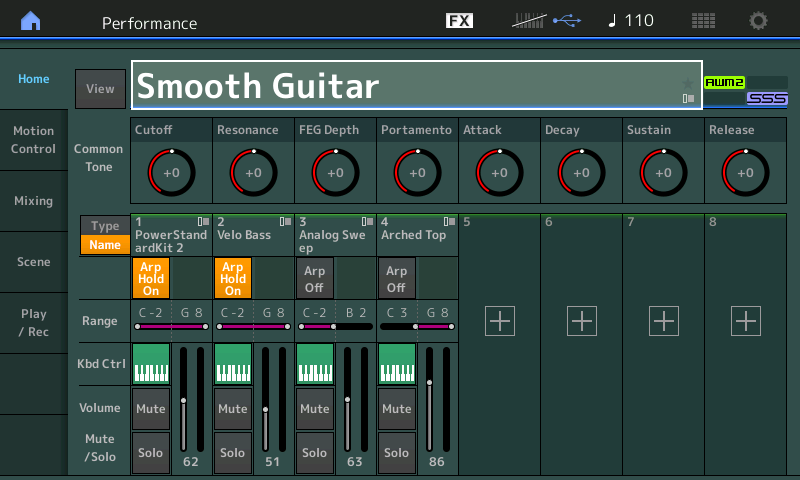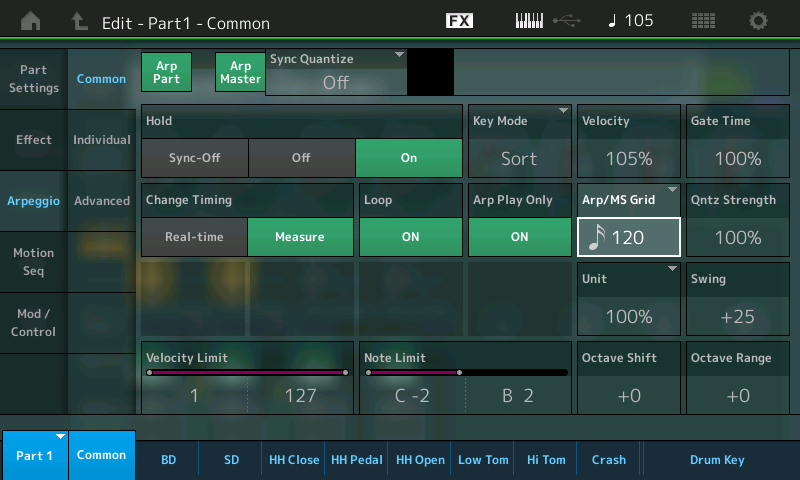Can anyone from Yamaha give me an example of a real scenario, or of an existing performance that actually needs limits of the arpeggio notes?
Sure. Find attached just such an example...
PART 1: Power Standard Kit 2 (Drums) sound across all keys under Arp control
PART 2: Velo Bass (Bass) sound across all keys under Arp control
PART 3: Analog Sweep (pad) sounds below B2 live on the keys
PART 4: Arched Top (Jazz Gtr) sounds above C3 live on the keys

Here you can start the song with a right hand (above C3) guitar into (no drums, no bass) ... and after the intro, your left hand trigger/controls the Drums, Bass and Pad... Notes played on the Guitar will not start the Drms/Bs nor will it influence the chord quality of the chord intelligence.
The Drums and Bass (both Arp’d) have their Arpeggio Note Limit set so that the right side of the keyboard can be freely engaged (with the Jazz Guitar) without starting (triggering) or entering chord control information to the active Arpeggiators.

Find attached a MODX CONNECT .X8B file which you can unzip and open with MODX CONNECT - which will dump it to your instrument's Edit Buffer - where you can explore it and see an example of when a Performance actually needs limits to the Arpeggio Notes!!!
By the numbers:
The number of people who play split keyboards - is HUGE. This is why what sounds on the keyboard is shown on the main HOME screen (you want to bury that) and place the ARP NOTE LIMITS on the main screen ? or is that you just don't really see the difference in the two?
The number of people who play with arpeggiators - is somewhat smaller. This and because all your setup stuff for Arpeggios are together within each PART.
You only setup one NOTE LIMIT (the PART's Note Limits) for what is SOUNDING but you need to setup 8 Arpeggios across three screens of settings to setup your Arps. We really think they are in the right places... Work with it a bit more, please, then get back to us.
Thanks, I will check this performance.
However you didn’t get my idea. It’s not to show arp limits on the main screen. It’s to change the meaning of those. For regular splits they will work in exactly the same way as now (only they will not limit the notes but limit the keyboard input which will basically be the same thing). However when arpeggio is enabled on the part this will mean they limit the keyboard input so you don’t trigger arps with the right hand. And if you need to limit notes instead then you can go in the arp menu.
With such a functionality both regular splits and arped splits will be apparent from the main screen. In your example you have shown a screenshot of the arp settings and the note limit. Because if that was not set, you would be able to trigger the bass and drum parts with the right hand and how can you know that from the main screen only?
That’s what I’m proposing. Doesn’t it really make sense to you? I’m a heavy split user. I propose that splits are kept easy as now but arps can be enabled/disabled without further tweaks or additional screens.
Ohh, I looked at your performance.
Seems you haven’t answered my question. I asked for an example of setting note limits on the main screen for arp enabled parts that are different than the entire range. Both your examples have the note limits set to the entire range. If there’s no good example of arp enabled parts with partially set note limits on the main screen, what’s the purpose of these limits then? That’s my question. Which is why I propose for arp enabled parts to use the main screen limits as keyboard limits and either ditch the current notion or put it in the arp menu screen instead.
Let me start all over again. I need to split the keyboard. And easily enable disable arpeggios for one part. Intuitively one would think he would set the note limits on the main screen, enable arp for one of the parts and then just toggle arpeggio button on/off. And all that is immediately apparent on the main screen only.
You tell me that’s not possible and I need to create separate scenes which means I need to remember that this performance contains such scenes and that won’t even be apparent on the main screen since note limits for the arpeggiated part is set to entire range and I need to see the actual keyboard limit in an additional menu.
Do you still not get the absurdity of the current way?
"Harp/Piccolo" splits C4 and up as flute (octave above middle C) and B3 and down as harp. Arpeggios are initially set off (master ARP is off) - so turning master ARP on will start the arpeggio.
Both the arpeggio and sounding note ranges stop at B3 (the split point) - as the upper range of both are set the same. What this does is it "short changes" the up-arpeggio for high notes in the Harp (near B3) that, without this limit (in the "General" settings PART note limits) would otherwise run higher up to play the full ARP.
The reason why both the PART (general) and Arpeggio upper note ranges are the same is because this Performance is setup to sometimes be used with the master ARP off - playing non-ARP notes of the harp. And strict trigger key enforcement is in place for both modes (ARP or not ARP). The General note limit is something that has a meaning under both modes - so you have to respect both modes in choosing the range.
If you wanted notes to sound higher while playing the ARP than they can sound when playing without the ARP (while still having the same trigger range) - then this could present an issue. Where the remedy would be to use a PART dedicated to ARP usage with its own note ranges and a PART dedicated to non-ARP usage (a carbon copy of the other PART except for note ranges).
It's really only an issue if you want the ARP to be able to play higher notes than your non-ARP can play.
If you do not need the ARP to play notes higher than the non-ARP - then you can program the note limit according to your split and the ARP is happily bound by those note limits.
I frequently have times when I only want my ARP to be triggered by a range of notes that's much smaller than the amount of notes that sound from the ARP. And I do not use this ARP sound in non-ARP mode, so the feature to have a different range of ARP trigger notes vs. ARP sounding notes is useful for me. Therefore, I do set the PART note limit much wider than the ARP note limit frequently.
Having a 3rd range which is a sounding note range of just the ARP itself could facilitate your usage. On the other hand, it'd be another source of possible confusion for others (another note range to figure out what it does).
Sometimes the problem is more of the ARP you've selected. When you strike a note - the ARP can play notes higher than your struck note - or notes lower - or the same note. If the ARP only strikes higher notes - then the ARP may not "work" when getting near the split point. However, a different ARP that plays only same or lower notes would work better. In which case, user ARPs or a different factory ARP may help.
I think I've made the same observation/point before (another forum, another lifetime ago) - that what Yamaha has is inherently overly confusing (at least to me) and could be better. I agree we have a setting (PART Note Limit) that limits the trigger notes when an ARP is not used. Why not keep that nailed down. If an ARP is used - use the same range for note trigger in both modes. Then have the ARP setting adjust the range of notes that an ARP can output? So if the ARP has higher notes above the trigger - we can make room for these with the buried parameter? Part of the answer - at least now with MODX/Montage - is that you have all of this content and training and docs and ... that has it like it is. I'm not sure it would help avoid confusion or problems to change it now. It's more of something to think about with a new platform (in my opinion).
